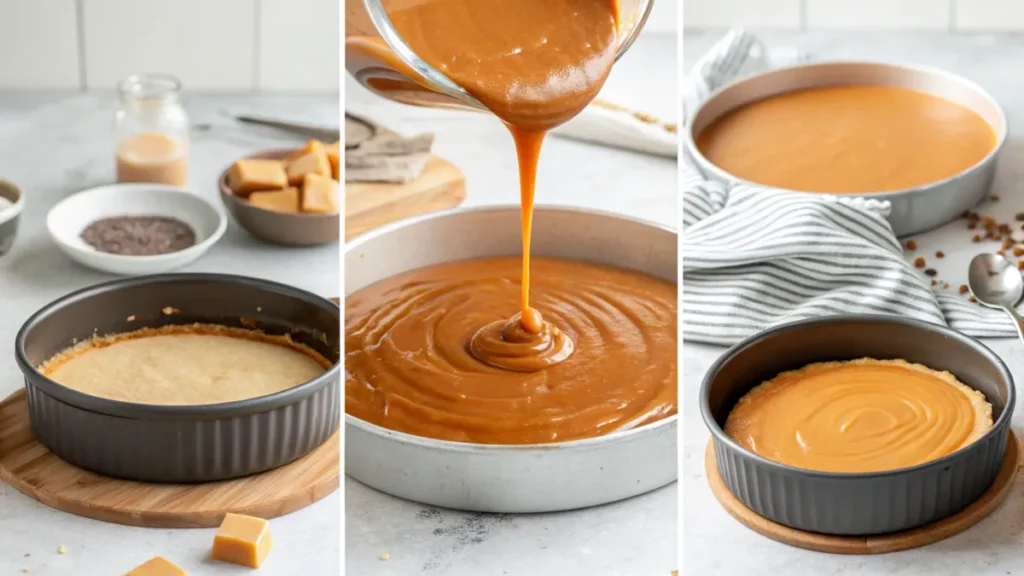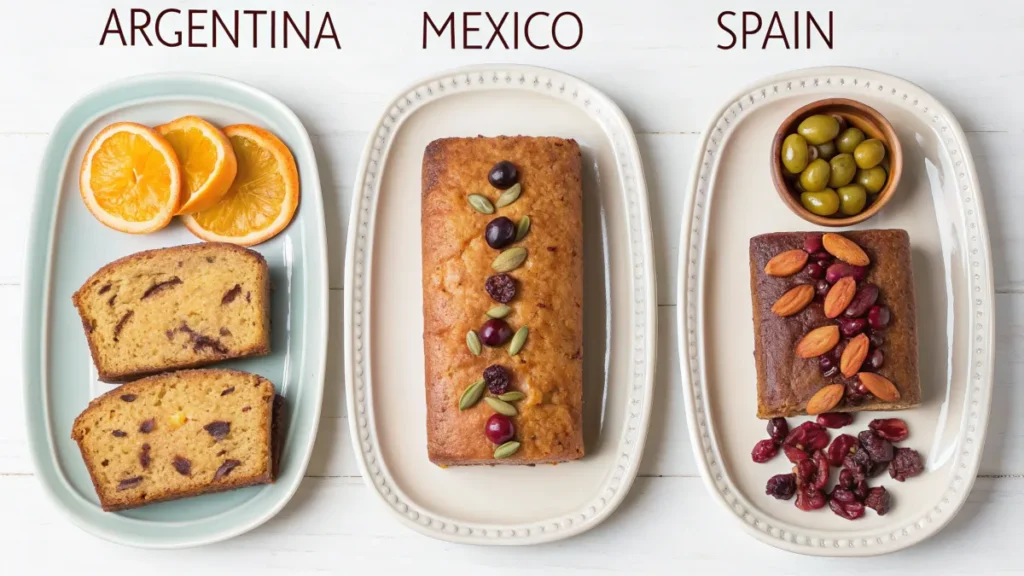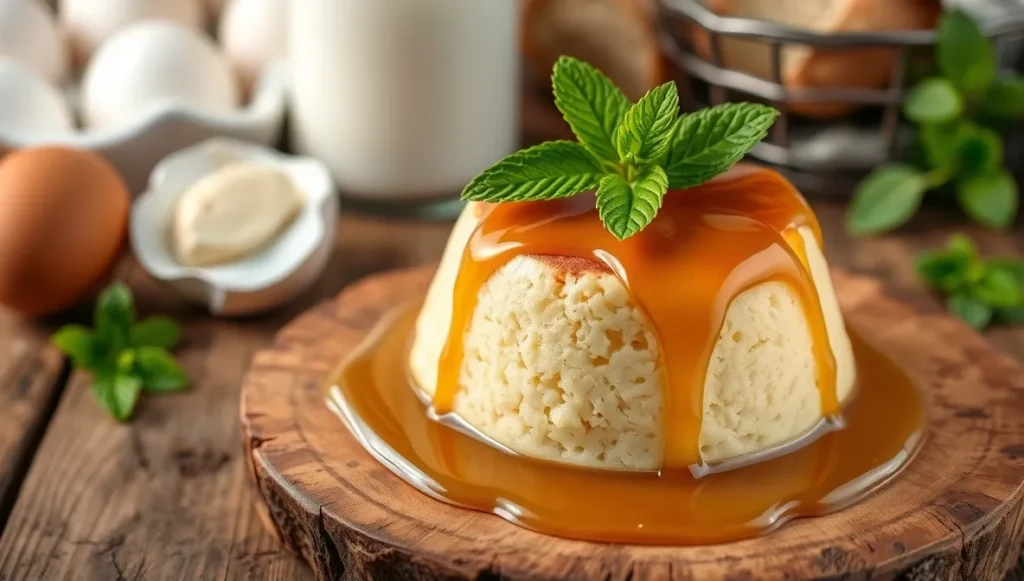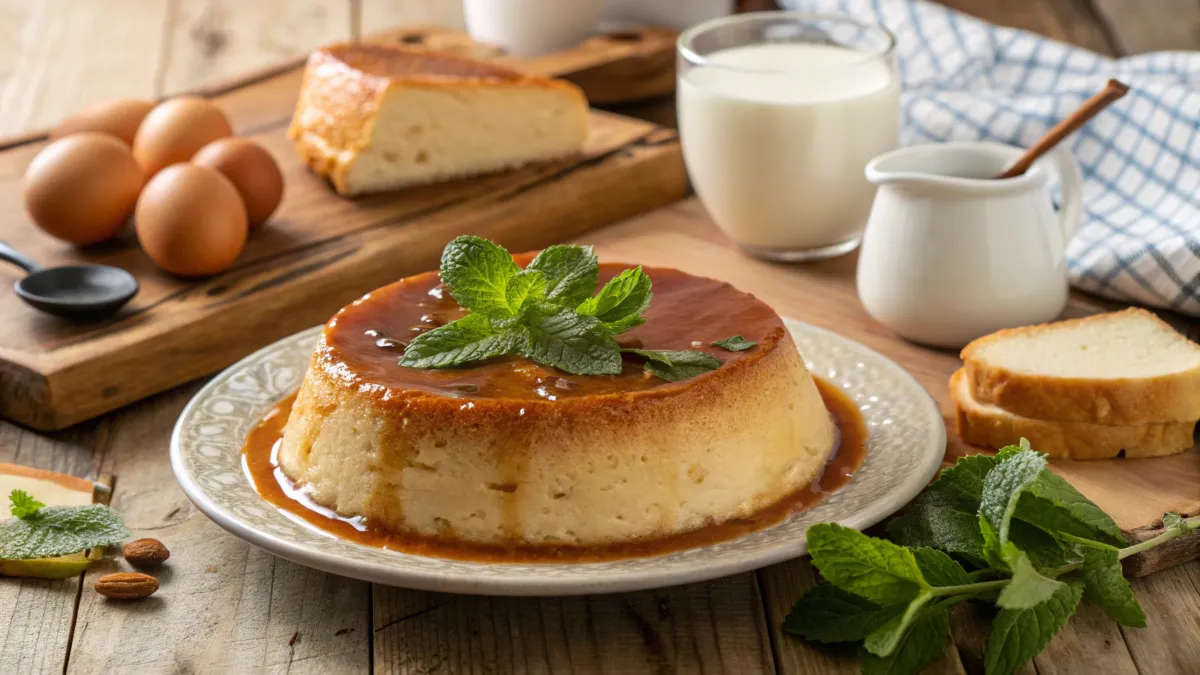Budín de Pan is more than just a dessert; it’s a sweet tradition passed down through generations. Whether you’ve tasted this comforting treat before or you’re hearing about it for the first time, this guide will take you on a delicious journey. We’ll explore its history, essential ingredients, variations, and tips to help you create the perfect Budin de pan at home. Let’s dive into the story of this cherished dish and learn how you can bring its magic to your table.
Budin de Pan
What is Budín de Pan?
Budin de Pan, often called bread pudding in English, is a dessert made from leftover bread, milk, eggs, sugar, and a hint of spices. It’s a fantastic way to transform stale bread into a creamy, flavorful treat. This dessert is known for its soft texture, rich taste, and caramel topping.
The dish holds a special place in Latin American cuisine. It’s commonly enjoyed during family gatherings, holidays, or as a sweet end to any meal. It is a symbol of resourcefulness, turning simple ingredients into something extraordinary.
A Brief History
The origins of Budin de pan trace back to medieval Europe, where bread pudding was a practical solution for using up stale bread. Over time, the recipe traveled across continents, gaining unique twists in Latin America.
Each country added its touch. In Argentina, it’s often served with a layer of dulce de leche. In Mexico, orange zest and cinnamon are popular additions. Regardless of the variation, the dessert remains a testament to culinary creativity and the joy of sharing simple yet delicious food.
Ingredients and Tools for Making Budín de Pan
Essential Ingredients
Making budín de pan is simple, and you probably already have the main ingredients at home. Here’s what you’ll need:
- Bread: Stale bread works best, as it absorbs the liquid mixture without falling apart. You can use French bread, baguettes, or even leftover sandwich bread.
- Milk: This adds creaminess and helps soften the bread. You can substitute with almond or coconut milk for a dairy-free option.
- Eggs: These are essential for binding the mixture and giving the dessert structure.
- Sugar: Used for both the batter and the caramel topping. White or brown sugar works equally well.
- Spices and Flavorings: Vanilla extract, cinnamon, and nutmeg are common additions that give Budin de pan its signature taste.
Optional ingredients include raisins, dried fruits, or chocolate chips for added flavor and texture.
Tools You’ll Need
Having the right tools makes the process easier:
- Baking Dish: A rectangular or round glass or ceramic dish works well.
- Mixing Bowl: For combining all the ingredients.
- Blender: If you prefer a smoother texture for your dessert.
- Saucepan: To prepare the caramel.
These items are all standard kitchen tools, so you won’t need any special equipment to get started.
Step-by-Step Recipe
Preparation of Ingredients
- Start by breaking the stale bread into small pieces and placing them in a large mixing bowl.
- In a separate saucepan, warm the milk with sugar and spices until the sugar dissolves. Pour this over the bread and let it soak for 10–15 minutes.
Making the Caramel

- Heat sugar in a saucepan over medium heat, stirring continuously until it melts and turns golden brown.
- Quickly pour the caramel into your baking dish, tilting it to coat the bottom evenly. Be careful, as caramel hardens fast.
Mixing and Baking the Budín de Pan
- Add eggs to the soaked bread mixture and blend gently with a whisk or blender. If you prefer a chunkier texture, skip the blender.
- Pour the mixture into the prepared baking dish with caramel.
- Bake in a preheated oven at 350°F (175°C) for 45–50 minutes, or until a toothpick inserted in the center comes out clean.
Once done, let the Budin de pan cool before flipping it onto a serving plate to reveal the glossy caramel top.
Variations of Budin de Pan
Traditional vs. Modern Takes
It has evolved over time. Traditional recipes often rely on simple ingredients, focusing on a caramel layer, creamy bread mixture, and subtle spices. Modern twists include using flavored syrups, chocolate chips, or cardamom. Some chefs even incorporate ingredients like dulce de leche or coconut milk for added richness.
For a lighter version, you can substitute regular milk with almond or oat milk and reduce the sugar. These variations showcase how versatile this dessert can be while still preserving its comforting roots.
Regional Variations

Every country has its unique spin on it. In Argentina, it’s common to drizzle dulce de leche on top before serving. Mexican versions may include orange zest and cinnamon, giving it a citrusy aroma. In Spain, stale baguette is the bread of choice, often combined with lemon rind. These regional differences highlight the universal love for this dessert while celebrating local flavors.
For more delicious recipes, check out the variety of dishes available on Every Tastes.
Serving and Enjoying Budin de Pan
Best Ways to Serve Budín de Pan

There are countless ways to serve Budin de pan. Many people enjoy it warm, straight out of the oven, as the caramel topping melts into the bread. Others prefer it chilled, allowing the dessert to set and the flavors to meld together. Either way, the soft texture paired with the sweet caramel makes it a favorite.
To elevate the experience, serve with whipped cream, a scoop of vanilla ice cream, or a sprinkle of cinnamon. These additions create a beautiful contrast and enhance the flavors of the dessert.
Pairing Suggestions
Pairing Budin de pan with the right beverage makes all the difference. A strong cup of coffee or a glass of milk complements its sweetness. For an adult twist, serve it with a dessert wine like Moscato or a dark rum. These pairings bring out the caramel and spice notes, making each bite even more enjoyable.
Health and Nutritional Information
Is Budín de Pan Healthy?
While Budin de pan is a delightful treat, it’s important to enjoy it in moderation. The dessert is rich in calories due to ingredients like bread, sugar, and eggs. A single serving can be quite satisfying, so you don’t need a large portion to indulge in its flavors.
On the bright side, It contains beneficial nutrients. Eggs provide protein, while milk offers calcium and vitamins. Additionally, if you use whole-grain bread, you’ll get a dose of fiber. The dessert is not overly processed, which makes it a better option compared to many store-bought sweets.
Healthier Alternatives
If you’re looking for ways to make it healthier, there are several adjustments you can try. Substitute sugar with natural sweeteners like honey or stevia. Use low-fat or plant-based milk instead of whole milk. You can even experiment with adding pureed fruits like bananas or apples to reduce the amount of sugar required.
By making small changes, you can enjoy Budin de pan guilt-free while still savoring its delicious taste.
Frequently Asked Questions about Budin de Pan
The beauty of Budin de pan lies in its flexibility. While stale bread is ideal because it absorbs the liquid mixture better, you can use any type of bread you have on hand. Baguettes, sandwich bread, or even sweet breads like brioche work wonderfully. For a unique twist, try using panettone or cinnamon swirl bread for extra flavor.
Absolutely! Freezing Budin de pan is a great way to preserve leftovers. Once the dessert has cooled completely, wrap it tightly in plastic wrap or place it in an airtight container. It can be stored in the freezer for up to three months. When you’re ready to enjoy it, simply thaw it in the fridge overnight and warm it in the oven before serving.
Caramel can be tricky, but don’t worry if it hardens before you pour the mixture. Simply place the saucepan back on low heat and stir until it softens again. Work quickly to coat the baking dish, as caramel solidifies as it cools. Practice makes perfect, so don’t be discouraged if it takes a few tries!
Quick Comparison of Regional Budín de Pan Recipes
Comparing Regional Differences
One of the fascinating aspects of it is how it varies across different regions. Although the base ingredients are similar, each version has its unique flair, shaped by local tastes and traditions. Here’s a quick comparison of popular variations:
| Region | Key Ingredients | Unique Additions | Cooking Method |
|---|---|---|---|
| Argentina | Stale bread, milk | Dulce de leche | Oven-baked |
| Mexico | Pan dulce, condensed milk | Orange zest | Oven-baked |
| Spain | Baguette, eggs | Lemon rind | Steamed |
| Caribbean | Coconut milk, sugar | Raisins | Oven-baked |
This variety shows how versatile and adaptable Budin de pan can be. No matter where you are, you can create a version that suits your preferences.
Tips for Perfecting Budin de Pan
Common Mistakes and How to Avoid Them
Even though making Budin de pan is simple, a few common mistakes can occur. Here are some tips to help you avoid them:
- Overcooking: If you bake it for too long, the dessert can become dry. Check for doneness by inserting a toothpick in the center. It should come out clean but slightly moist.
- Caramel Troubles: Caramel can burn easily. Keep a close eye on it and use low heat to maintain control. Stir constantly for the best results.
- Poor Texture: The bread-to-liquid ratio is crucial. Too much bread can make it dense, while too much liquid can result in a soggy dessert. Stick to the recipe proportions for a perfect texture.
Secrets to a Smooth Texture
To achieve the creamiest budin de pan, let the bread soak in the milk mixture until it’s fully absorbed. Blending the mixture can also help create a smoother texture. However, if you prefer a chunkier feel, skip the blender and gently mash the bread instead.
Adding a pinch of salt to balance the sweetness is another secret tip. It enhances the flavors and prevents the dessert from tasting overly sugary.
Creative Twists on Budín de Pan
Savory Variations
- Cheese and Herb Budín: For a savory twist, incorporate shredded cheese, fresh herbs like thyme or rosemary, and a pinch of garlic powder into the bread mixture. This version can be served as a side dish or a main course for brunch.
- Vegetable Budín: Add sautéed vegetables like spinach, mushrooms, or bell peppers to the bread mixture. This not only adds flavor but also increases the nutritional value of the dish.
Dietary Adaptations
- Gluten-Free Budín: Use gluten-free bread to make a version that everyone can enjoy. Ensure all other ingredients are also gluten-free to avoid cross-contamination.
- Vegan Budín: Substitute eggs with flax seeds or chia seeds mixed with water to create a gel-like consistency. Use plant-based milk and ensure all other ingredients are vegan-friendly.
Budín de Pan Around the World
Global Influences
- French Inspiration: Incorporate elements from French cuisine by adding a layer of crème brûlée on top. Torch the sugar to create a crispy, caramelized surface.
- Italian Touch: Use panettone, an Italian sweet bread, as the base. Add a layer of mascarpone cheese mixed with a hint of espresso for a tiramisu-like flavor.
Fusion Creations
- Asian Fusion: Infuse the milk mixture with matcha powder or add a layer of sweet red bean paste for an Asian-inspired twist.
- Middle Eastern Flavors: Incorporate dates, pistachios, and a hint of cardamom into the bread mixture. Serve with a drizzle of honey for added sweetness.
Budín de Pan for Special Occasions
Festive Ideas
- Holiday Budín: Add festive spices like nutmeg, cloves, and allspice. Top with a layer of cranberry compote for a burst of tartness that complements the sweet caramel.
- Birthday Budín: Create a celebratory version by adding colorful sprinkles to the batter and topping with a layer of chocolate ganache. Serve with a scoop of birthday cake-flavored ice cream.
Romantic Settings
- Valentine’s Day Budín: Incorporate strawberries or raspberries into the bread mixture for a romantic touch. Serve with a side of chocolate-dipped strawberries and a glass of sparkling wine.
- Anniversary Budín: Use a heart-shaped baking dish and add a layer of dulce de leche infused with a hint of lavender for a unique and memorable dessert.
Conclusion
Budín de Pan is more than just a dessert; it’s a culinary journey that transcends borders and generations. From its humble origins as a way to use stale bread to its modern, creative variations, this dish continues to evolve and delight. Whether you prefer the traditional caramel-topped version or a savory twist with cheese and herbs, there’s a Budín de Pan for every palate and occasion.
Embrace the versatility of this beloved dessert by experimenting with different ingredients and flavors. Whether you’re hosting a family gathering, celebrating a special occasion, or simply looking for a comforting treat, Budín de Pan is sure to impress. With its rich history and endless possibilities, it remains a timeless classic that brings people together, one sweet bite at a time.

